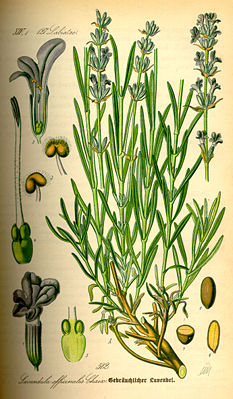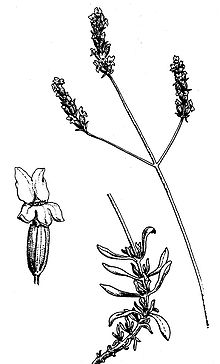Lavender (genus)
| lavender | ||||||||||||
|---|---|---|---|---|---|---|---|---|---|---|---|---|

Real lavender ( Lavandula angustifolia ), illustration |
||||||||||||
| Systematics | ||||||||||||
|
||||||||||||
| Scientific name | ||||||||||||
| Lavandula | ||||||||||||
| L. |
Lavender ( Lavandula ) is a plant genus in the family of the mint (Lamiaceae). The 28 to 37 species are distributed from Macaronesia across the Mediterranean to Western Asia and the Indian subcontinent . The real lavender ( Lavandula angustifolia ), the Speik lavender ( Lavandula latifolia ) and the Lavandin ( Lavandula hybrida ) are economically important .
description


Vegetative characteristics
The lavender species are subshrubs , small shrubs or rarely perennial herbaceous plants . Young twigs are often square. All parts of the plant contain essential oils .
The aromatically fragrant, opposite to whorled arranged, sessile leaves are entire, rarely toothed or pinnate, and often densely hairy.
Generative characteristics
Half whorls stand in terminal, long-stalked false ears . In the armpits of the often membranous or colorful bracts , which are clearly different from the leaves and barely rise above the calyxes, the half-whorls usually contain three to five (one to ten) flowers. If there are cover sheets , then they are relatively small. The flowers are short-stalked or almost sessile.
The hermaphrodite flowers are zygomorphic and five-fold with a double flower envelope . The five sepals are fused with mostly 13 (8 to 15) nerves; the calyx tube is cylindrical, its upper lip is mostly monodentate and the lower lip is four-toothed. The calyx teeth are small, the upper one has a heart-shaped or obovate appendage at the tip. The five petals are fused to form a two-lipped crown, which is usually an intense blue to purple color. The upper lip has two, the lower lip three rounded, flat or slightly curved corolla lobes. There are two longer and two shorter stamens , all of which are fertile and curved in front. Stamens and styles are shorter than the corolla tube and therefore not visible. Two carpels have become a top permanent ovary grown, which is divided by a false septum into four parts. The simple stylus has two flat, egg-shaped scar lobes .
The Klausen fruits disintegrate into four thin-skinned, shiny Klausen, which have a small, basal to dorsal attachment surface (areole).
ecology
The pollination is done by insects ( Entomophilie ) or birds ( ornithophily ).
Systematics and distribution






The genus Lavandula was established in 1753 by Carl von Linné in Species Plantarum . Synonyms for Lavandula L. are: Chaetostachys Benth. , Fabricia Adans. , Isinia Rech. F. , Sabaudia Buscal. & Muschl. , Stoechas Mill. , Styphonia Medik.
The genus Lavandula belongs to the Untertribus Lavandulinae of the tribe Ocimeae in the subfamily Nepetoideae within the family Lamiaceae .
The genus Lavandula occurs wild on the Atlantic islands, in the Mediterranean, Africa, Southwest Asia to India . Seven species occur in Europe. Isolated naturalized stocks of real lavender also exist north of the Alps.
The genus Lavandula is divided into three sub-genera and eight sections and contains 28 to 37 species:
- Subgenus Lavandula :
- Section Lavandula :
- Real lavender ( Lavandula angustifolia Mill. ): The two subspecies occur from northeastern Spain via France to Italy . He is a neophyte in many areas .
- Woolly lavender ( Lavandula lanata Boiss. , Syn .: Lavandula spica var. Tomentosa Lundmark , Lavandula spica var. Lanigera Webb , Lavandula tomentosa (Lundmark) Pau ): It is found only in southern Spain.
- Broad-leaved lavender ( Lavandula latifolia Medik. ): It is widespread from Spain to Italy .
- Dentatae Suarez-Cerv Section . & Seoane-Camba :
- French lavender ( Lavandula dentata L. ): It is widespread in the western Mediterranean region , in northeastern Africa and in the Middle East. One can distinguish two varieties.
- Section Stoechas Ging. :
- Lavandula pedunculata (Mill.) Cav. : The five subspecies are distributed from the Iberian Peninsula across northwest Africa and Aegean Sea to Turkey .
- Crested lavender ( Lavandula stoechas L. ): It is common in the Mediterranean region.
- Lavandula viridis L'Hér. : The home is southern Portugal and southwestern Spain.
- Section Lavandula :
- Subgenus Fabricia (Adams.) Upson & S. Andrews :
- Section Pterostoechas Went. :
- Lavandula antineae Maire : It is native to the Sahara Mountainsin Algeria , Niger , Sudan and Chad . There are three subspecies.
- Lavandula bramwellii Upson & S.Andrews : It is endemic to the island of Gran Canaria .
- Lavandula buchii Webb & Berthel. : She is endemic to the island of Tenerife . Three varieties can be distinguished.
- Lavandula canariensis (L.) Mill .: The seven subspecies occur in the Canaries .
- Lavandula citriodora A.G. Mill. : It only occurs on the southwestern Arabian Peninsula .
- Lavandula coronopifolia Poir. : The distribution area extends from the Cape Verde Islands to southern Iran .
- Lavandula mairei Humbert : The homeland is Morocco . One can distinguish two varieties.
- Lavandula maroccana Murb. : The homeland is Morocco.
-
Lavandula minutolii Bolle : There are two varieties:
- Lavandula minutolii Bolle var. Minutolii : This endemic only occurs in central to southern Gran Canaria.
- Lavandula minutolii var. Tenuipinna Svent. : This endemic occurs only in western Tenerife.
- Fern-leaved lavender ( Lavandula multifida L. ): The range extends from southern Portugal through Spain and Sicily to southern Italy and from North Africa to northeastern Sudan .
- Lavandula pinnata Lundmark : It occurs only in Madeira and Lanzarote .
- Lavandula pubescens Decne. : The distribution area extends from the south-eastern Mediterranean to the western Arabian Peninsula.
- Lavandula rejdalii Upson & Jury : It only occurs in southern Morocco.
- Lavandula rotundifolia Benth. : Cape Verde is our home.
- Lavandula saharica Upson & Jury : The home is southern Algeria , southern Libya and southwestern Egypt.
- Lavandula tenuisecta Coss. ex Ball : The homeland is Morocco.
- Section Subnudae Chaytor :
- Lavandula aristibracteata A.G. Mill . : This endemic occurs only in northern Somalia .
- Lavandula dhofarensis A.G. Mill. : This endemic occurs only in southern Oman . One can distinguish two subspecies.
- Lavandula galgalloensis A.G. Mill . : This endemic occurs only in northern Somalia.
- Lavandula macra Baker : It is native to northern Somalia and the southern Arabian Peninsula.
- Lavandula nimmoi Benth. in APde Candolle : It is endemic to the island of Socotra .
- Lavandula qishnensis Upson & S.Andrews : This endemic species only occurs in southeastern Yemen .
- Lavandula samhanensis Upson & S.Andrews : This endemic only occurs in southern Oman.
- Lavandula setifera T.Anderson : It is native to northeastern Somalia and southern Yemen.
- Lavandula somaliensis Chaytor : This endemic only occurs in northern Somalia.
- Lavandula subnuda Benth. : The homeland are the states of the Arabian Peninsula on the Persian Gulf and northeastern Oman.
- Section Chaetostachys Benth. :
- Lavandula bipinnata (Roth) Kuntze : The home is India .
- Lavandula gibsonii J.Graham : It occurs only in western and south-western India.
- Section Hasikenses Upson & S.Andrews :
- Lavandula hasikensis A.G. Mill . : This endemic occurs only in southern Oman.
- Section Pterostoechas Went. :
- Subgenus Sabaudia (Buscal. & Muschl.) Upson & S.Andrews :
- Section Sabaudia (Buscal. & Muschl.) Upson & S.Andrews :
- Lavandula atriplicifolia Benth. : The homeland is Egypt and the western Arabian Peninsula.
- Lavandula erythraeae (Chiov.) Cufod. : This endemic occurs only in Eritrea .
- Section Sabaudia (Buscal. & Muschl.) Upson & S.Andrews :
Oil extraction
Lavender oil is made from the inflorescences with stems . See main article → Real Lavender
literature
- Siegmund Seybold (Ed.): Schmeil-Fitschen interactive . CD-ROM, version 1.1. Quelle & Meyer, Wiebelsheim 2002, ISBN 3-494-01327-6 .
- Tim Upson, Susyn Andrews, Georita Harriott, Christabel King, Joanna Langhorne: The Genus Lavandula. Timber Press, Portland, Oregon 2004, ISBN 0-88192-642-6 .
Individual evidence
- ↑ a b c d e f g h i j k l m n o p q r s t u v w x y z aa ab ac ad ae af ag ah ai aj ak al am an ao ap aq ar as at au Rafaël Govaerts (Ed.): Lavandula. In: World Checklist of Selected Plant Families (WCSP) - The Board of Trustees of the Royal Botanic Gardens, Kew . Retrieved January 16, 2018.
- ↑ a b c d e Xi-wen Li, Ian C. Hedge: Lavandula. In: Wu Zheng-yi, Peter H. Raven (Ed.): Flora of China . tape 17 : Verbenaceae through Solanaceae . Science Press / Missouri Botanical Garden Press, Beijing / St. Louis 1994, ISBN 0-915279-24-X , pp. 103-104 (English, online ).
- ↑ Carl von Linné: Species Plantarum. Volume 2, Lars Salvius, Stockholm 1753, p. 572 ( digitized version ).
- ↑ Tim Upson, Susyn Andrews, Georita Harriott, Christabel King, Joanna Langhorne: The Genus Lavandula. Timber Press, Portland, Oregon 2004, ISBN 0-88192-642-6 .